Cats are independent creatures who only cooperate with us humans when they feel like it. No matter how much “pspspsps” and “kittykittykitty” you attempt to attract a feline, if it isn’t in the mood, you’ll get ignored. Animal rescuers, feline welfare educators, and down-to-earth social media celebrities Hannah Shaw (AKA Kitten Lady) and her husband Andrew Marttila (AKA The Cat Photographer), however, have found a surefire way to connect with cats. So much so that during their travels in 30 countries around the world, they managed to take over 700 photographs of the local cats and turn them into a gorgeous book: Cats of the World.
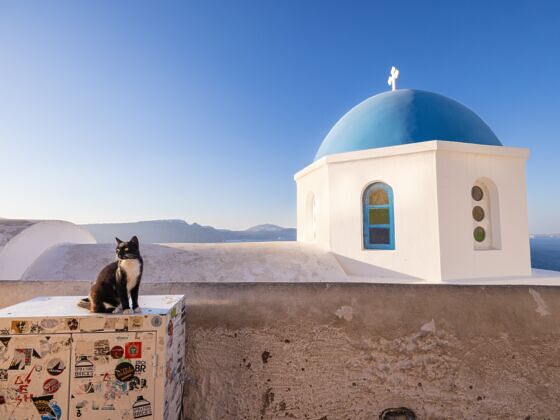

‘Cats of the World’ Is the Perfect Book for Feline-Loving Travelers
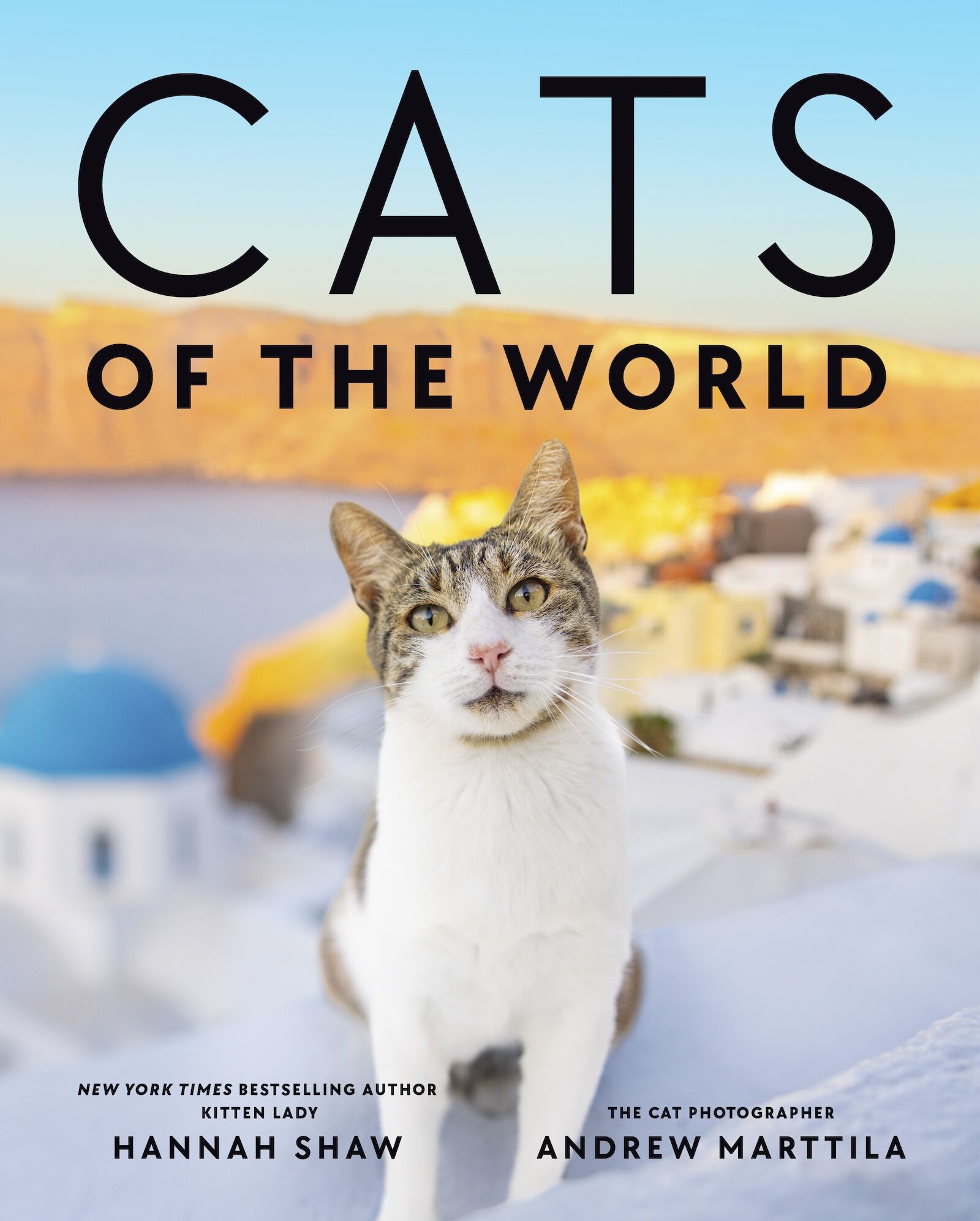
Photo: Hannah Shaw and Andrew Marttila
“We learned early on to pack pounds of cat treats for our excursions,” Andrew explained in an email conversation. “We employed various methods to get them comfortable with us and then fall head-over-paws in love with us through our use of treats and affection.”
In just about every photograph Andrew took, the cats seem to position themselves for him to capture the most flattering and striking image, whether in front of the blue domes of Santorini, Greece, or at a market stall in Santiago, Chile.
“In many of the shoots, cats followed us around as though they were saying, ‘Oh, you want me to pose here? No problem!’ and I’d get the shot,” says Andrew.
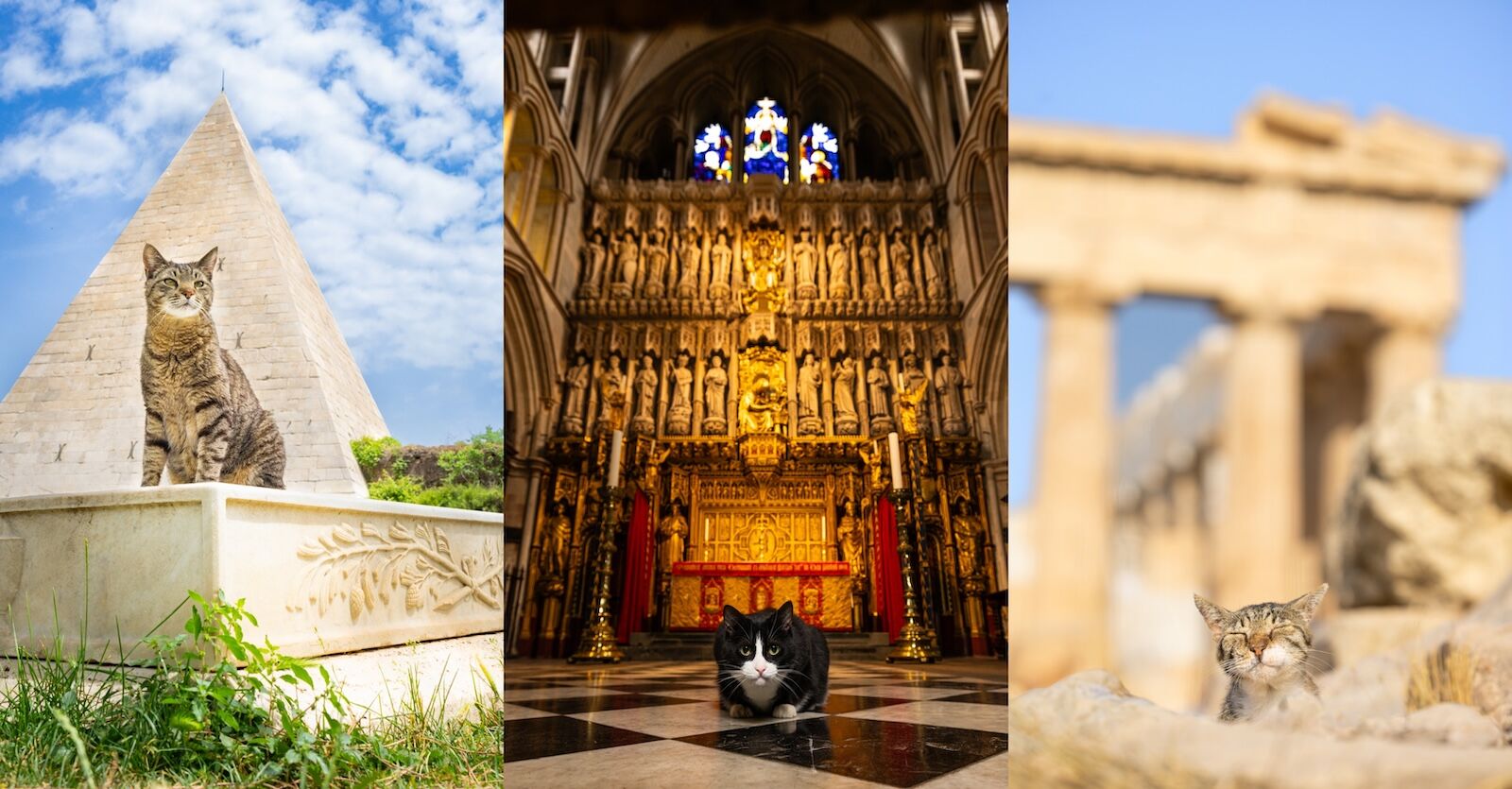
Cats around the world (Italy, England, Greece) posed for Andrew. The central image shows Hodge, who lives at Southwark Cathedral in London. Photos: Hannah Shaw and Andrew Marttila
But while it is filled with great images, Cats of the World is much more than just a collection of photographs. During their travels, Hannah and Andrew explored the social and cultural significance of felines through interviews with locals, and observed how cats and humans interact. While abroad, Hannah and Andrew, cat rescuers at home in the US, volunteered in shelters and helped the cats in distress they encountered. They brought all their stories back with them and included them in the book to delight and educate all the cat-loving travelers out there.
We talked to Hannah and Andrews about their international cat-focused travels and the making of this fantastic book.
This interview has been edited for length and clarity.
Matador: What would you say is the mission of Cats of the World?
Hannah: Our mission with Cats of the World is to dive deep into the compelling relationship between humans and cats around the world. Through storytelling and photography, the book offers a beautiful window into the lives of cats in dozens of cultural contexts, and spotlights the advocates who are making the world a better place for cats.
How did the idea for this book come about?
As animal rescuers, Andrew and I have always found ourselves drawn to connecting with cats (and cat people!) everywhere we travel. Prior to envisioning the book, we had several fascinating experiences abroad that opened our eyes to the myriad of ways cats live and the unique relationships they share with their communities. I became very interested in the role that culture, religion, climate, access to resources, and other factors play in cat welfare, and what lessons we might learn that could inform how we approach the protection of cats here in the US.
It was actually a very simple but moving moment in Malaysia that sparked Cats of the World. We’d followed a cat into a meat market in Penang, where a feline family was sprawled across the slabs and enjoying the afternoon together. Inside, a little kitten was illuminated under a skylight and I was struck by how my very Western, anthropocentric instinct to want to ‘help’ her seemed totally senseless in this context; even though the city had few official resources for cats, this kitten was actually so much safer being embraced by a community that sees her as a part of it than she would be in a municipal institution! During that trip, we encountered so many great examples of cats and humans living in harmony together. We began wishing we could share these moments with others in a deeper way — and started to map out what it would look like to create a book exploring the lives of cats around the world.
Where, during your travels, did you see the most cats?
The highest density of cats we encountered may have been in the home of Marayam Al-Balushi, a rescuer in Oman who has turned her house into a fully staffed animal shelter for over 500 animals. Sitting in the bed she shares with dozens of feline friends, she shared how her Islamic faith informs her dedication to the animals. She said, “Messenger Muhammad says cats are part of the family. And he tells that if any blind cat comes to the house, you give him food.”
Is there one particular destination where you were surprised at the locals’ relationship with cats?
I really loved learning about the relationship between cats and humans in Lamu, a remote island off the coast of Kenya. “Every house has a cat and a donkey. The donkey is the transportation; the cat is the security,” one local told us of the many felines who lounge in and around the traditional Swahili homes. With fishing being such a large part of the culture in Lamu, cats are regularly seen sitting patiently as fishermen clean their catch, and there’s always plenty of dinner to go around. “If you know the cats, God knows you,” one fisherman told us as he fed the cats.
Did you notice a difference in the appearance and behaviors of the cats in the destinations you traveled to?
Cats have truly evolved to adapt to their environments, so it came as no surprise to us that the domestic cats of chilly Finland appeared much burlier, with thicker coats, while the Arabian maus you see around arid Kuwait have evolved to be slender and single-coated. Perhaps one of the most interesting regional traits is the prevalence of shortened or kinked tails in East Asia.
Were there heartbreaking and heartwarming moments during your travels that stuck with you?
We definitely encountered some heartbreaking moments, but worked to be part of the solution when possible. On several occasions we encountered cats whom we needed to bring in for emergency care or even euthanasia. One difficult moment that stands out to me was during our time in Istanbul, when we spotted two cats with severe medical needs languishing in a park by our hotel. But by working with our local friend Sarper Duman, we were able to catch them, donate the cost of their care, and ultimately help save both cats — who made full recoveries!
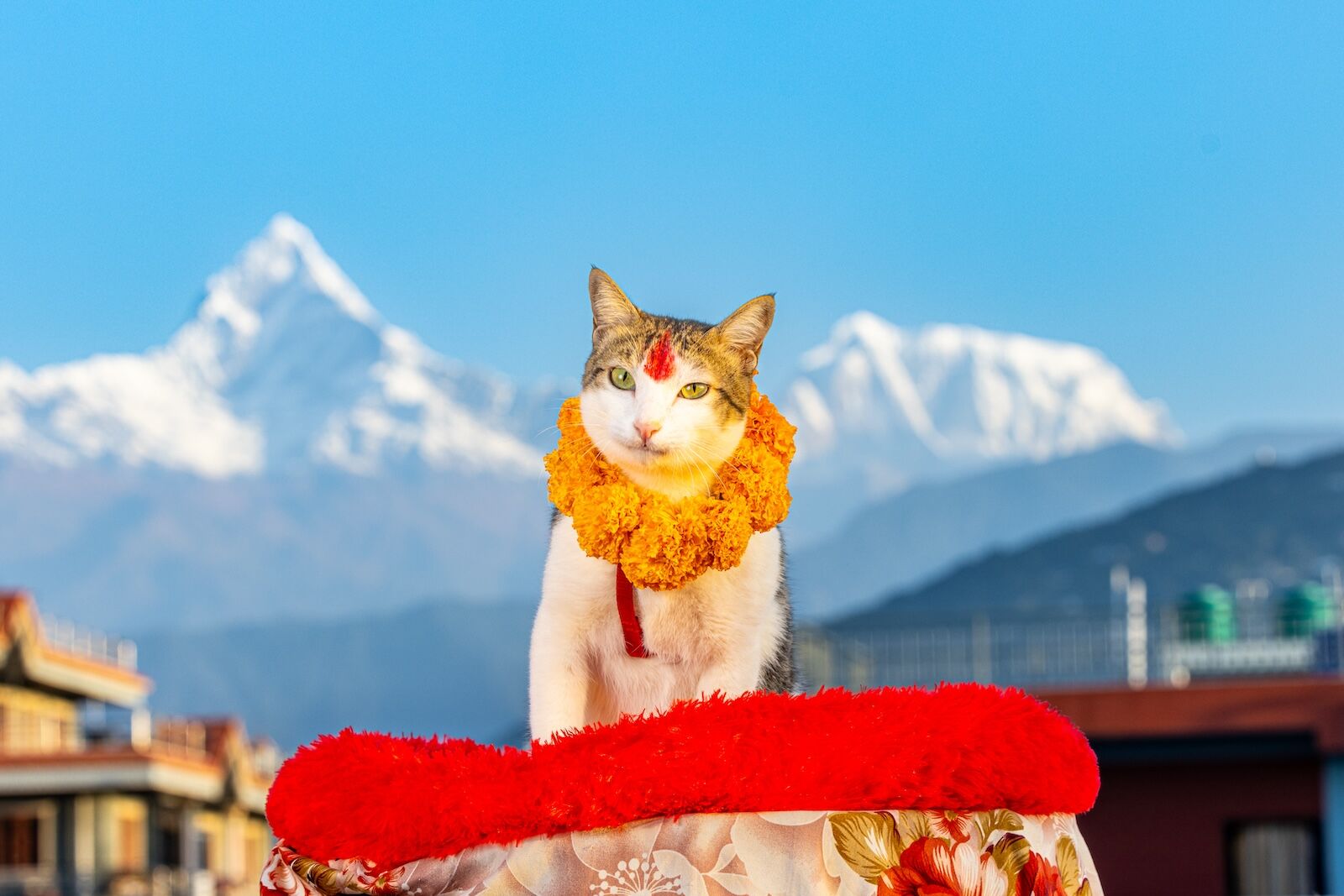
A cat in Pokhara, Nepal during Kukur Tihar. Photo: Hannah Shaw and Andrew Marttila
One of the most heartwarming experiences we had was definitely visiting Pokhara, Nepal during Kukur Tihar, a Hindu festival in which dogs and cats are worshipped. It was incredible to see how even community animals and shelter cats were adorned with marigold garlands and given special treats on this day.
Is there one cat or one story that touched you in particular during your travels and in the making of this book?
I’ll never forget meeting Hodge, who lives at Southwark Cathedral. This rescued tuxedo cat lives freely in the oldest Gothic cathedral in London, and is truly adored by both the congregation and the staff. On the one hand, it was absolutely hilarious to hear the stories of him interrupting their services by climbing on the pulpit or stubbornly occupying the Bishop’s throne. On the other hand, it was truly touching to listen to the clergy sharing the importance of opening one’s door to those in need — whether they’re reaching out for help with hands or with paws.
Where would you advise cat lovers to travel to for the most chance at kitty sightings and cuddles?
I advise that travelers wanting to encounter cats reach out to local organizations and see how to visit or help them. There are incredible cat rescues that you can visit all around the world — places like De Poezenboot, a cat boat in the canals of Amsterdam, or Cat Cafe Studio, a wonderful rescue in Mumbai. You can also find community-based organizations that need volunteers — for example, we volunteered with a My Big Fat Caribbean Rescue spayathon in Vieques, Puerto Rico, and helped out a Trap-Neuter-Return (TNR) organization, Sterila, in Santorini, Greece. It’s one thing to travel and see cats, but it’s another to engage with the local advocates and lend a hand. In our experience, getting active with local cat rescuers is an amazing way to see a different side of the community you’re visiting.
What do you want your readers to experience when reading Cats of the World?
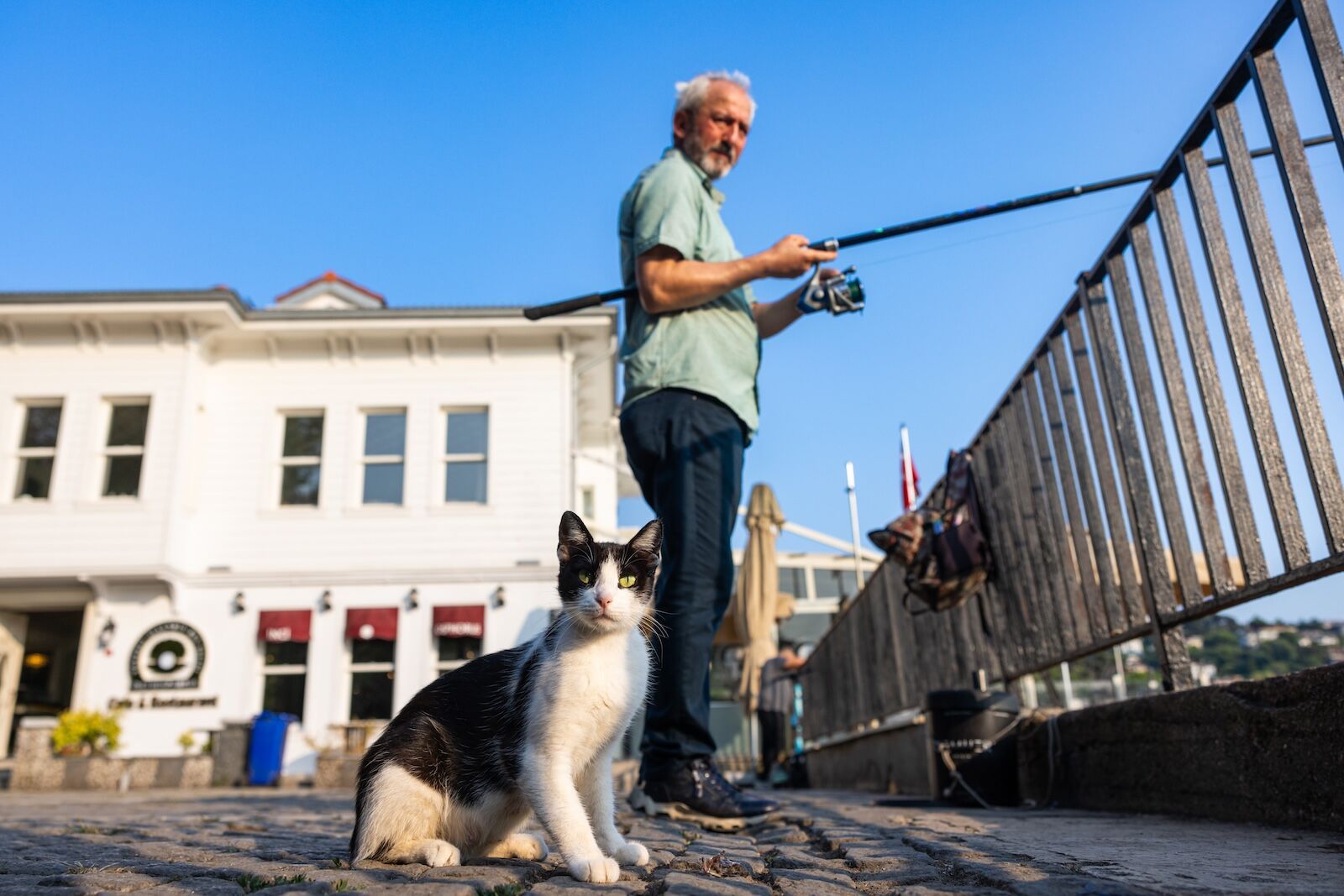
Photo: Hannah Shaw and Andrew Marttila
I think on its surface, this is a travel book where, through my lens, you get to see so many beautiful, iconic destinations that have cats. If you’re just in it for the photos, we have you covered. But you’d be doing a grave disservice if you didn’t take the time to read the chapters for each country! Within the pages, you will undoubtedly derive a greater appreciation for felines in all of their contexts and those who care for them. In the US, we predominantly see cats as indoor animals who exist primarily to complement our home life. In most of the world, however, they are autonomous beings with complex relationships with the people and other animals where they live.
Cats of the World releases on October 15. Below, an excerpt of the introduction for a taste of the book.
We hope you love the books we recommend! Just so you know, Matador may collect a small commission from the links on this page if you decide to make a purchase. Listed prices are accurate as of the time of publication.
INTRODUCTION
Where there are humans, there are cats. In nearly every corner of the earth, cats have integrated into our societies, their lives inextricably intertwined with ours. The connection we share knows no bounds and no borders.
The human-feline origin story is one of interdependence. It begins with the advent of agriculture, when the cultivation of grain catapulted our potential as a species but also attracted rodents who threatened our crops. Enter: cats. Valuing their prowess as hunters, we formed an unlikely alliance that would ensure our mutual survival, and the stage was set for a symbiotic partnership that would eventually extend its influence across the globe.
Since the dawn of international travel, cats have been along for the journey. As early seafarers explored and traded, cats disembarked from the ships, spreading far and wide until the world map was covered in paw prints. Today, the question is not whether cats will inhabit areas of human settlement, but how we will engage with them when they do.
Humans have cast cats in diverse roles throughout history and across cultures—villain and hero, nuisance and muse, invader and beloved companion. A wide variety of factors have converged to influence these impressions, such as folklore and belief systems, culture and politics, even climate and topography. We may all share Felis catus as a neighbor, but our perspectives vary as much as the languages we use to describe them.
Regardless of where we live, every community has one thing in common: there is always someone showing kindness to cats. The Kenyan fisherman shares his catch. The French foster parent bottle-feeds kittens in her flat. The Chilean shopkeeper adopts a resident feline. Humans navigate through a wide spectrum of circumstances –the abundance or scarcity of resources, the absence or presence of laws — but as we face a kaleidoscope of regional differences, a common virtue connects us all. Compassion is a universal language.
Excerpted with permission from Cats of the World by Hannah Shaw and Andrew Marttila. The book releases on October 15.